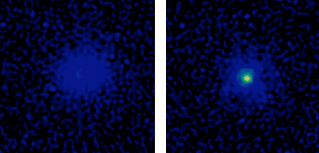CANARY: First On-Sky Demonstration of
Multi-Object Adaptive Optics
ING web news release
29 December, 2010
A Franco-British team
has demonstrated for the first time on-sky the feasibility of
so-called Multi-Object Adaptive Optics (MOAO).
MOAO provides the high spatial resolution delivered by current
adaptive-optics systems, but over a much larger field of view, allowing
many objects to be observed simultaneously.
The demonstration was made
with the purpose-built CANARY instrument installed at the
Nasmyth focus of the William Herschel Telescope on La Palma. Analysis of the
first results obtained in September 2010 shows that CANARY
delivered
the expected performance the first time it was used
- a spectacular success.
This test demonstrates the feasibility of the EAGLE instrument,
to be mounted on the
42-meter European Extremely Large Telescope (E-ELT) of the European Southern
Observatory (ESO).
EAGLE will observe simultaneously up to 20 galaxies
within a 5-arcminute diameter
field of view (1/6 the apparent width of the full Moon).
The recent experiment with
CANARY on the WHT (mirror diameter 4.2 meters) is in many respects
a 10-times scaled-down version of EAGLE on the E-ELT.
Multi-Object Adaptive Optics uses one deformable mirror
per target, with the required movements of each
deformable mirror being derived from the wavefront measurements
made on all the guide stars in the field of view
(3 in the case of CANARY)
i.e. via global tomography of the atmosphere.
The next phase of the CANARY experiment will be to replace
the natural guide stars by artificial
guide stars generated in the atmosphere using powerful lasers.
Such laser guide stars are essential for operating
EAGLE on the E-ELT.
Laser guide stars have been used before, but never to perform
tomographic measurements - this will be a first for CANARY.
 |
|
Images recorded in the near infrared (1.65 microns) by CANARY. Left,
without any correction for the atmospheric turbulence.
Right, with correction (~ 150 times per sec), recovering the
diffraction limit of the telescope [ GIF ].
|
More information:
A Powerful Innovative Adaptive-Optics Technology To Survey the Early Universe", Paris Observatory and CNRS Press Release, 17 December 2010.
Available formats: TXT (local copy) | HTML (in French).



